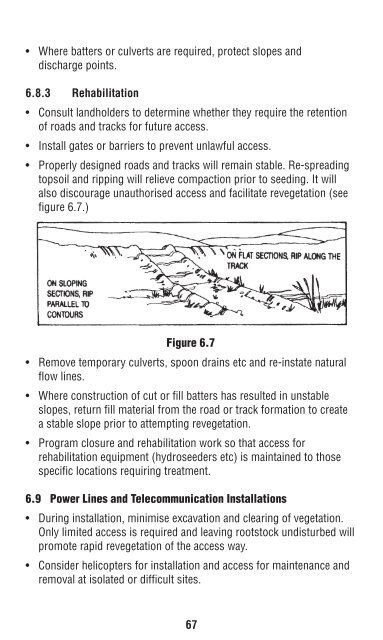Mine Rehabilitation Handbook - Mining and Blasting
Mine Rehabilitation Handbook - Mining and Blasting
Mine Rehabilitation Handbook - Mining and Blasting
You also want an ePaper? Increase the reach of your titles
YUMPU automatically turns print PDFs into web optimized ePapers that Google loves.
• Where batters or culverts are required, protect slopes <strong>and</strong><br />
discharge points.<br />
6.8.3 <strong>Rehabilitation</strong><br />
• Consult l<strong>and</strong>holders to determine whether they require the retention<br />
of roads <strong>and</strong> tracks for future access.<br />
• Install gates or barriers to prevent unlawful access.<br />
• Properly designed roads <strong>and</strong> tracks will remain stable. Re-spreading<br />
topsoil <strong>and</strong> ripping will relieve compaction prior to seeding. It will<br />
also discourage unauthorised access <strong>and</strong> facilitate revegetation (see<br />
figure 6.7.)<br />
Figure 6.7<br />
• Remove temporary culverts, spoon drains etc <strong>and</strong> re-instate natural<br />
flow lines.<br />
• Where construction of cut or fill batters has resulted in unstable<br />
slopes, return fill material from the road or track formation to create<br />
a stable slope prior to attempting revegetation.<br />
• Program closure <strong>and</strong> rehabilitation work so that access for<br />
rehabilitation equipment (hydroseeders etc) is maintained to those<br />
specific locations requiring treatment.<br />
6.9 Power Lines <strong>and</strong> Telecommunication Installations<br />
• During installation, minimise excavation <strong>and</strong> clearing of vegetation.<br />
Only limited access is required <strong>and</strong> leaving rootstock undisturbed will<br />
promote rapid revegetation of the access way.<br />
• Consider helicopters for installation <strong>and</strong> access for maintenance <strong>and</strong><br />
removal at isolated or difficult sites.<br />
67<br />
• Remove cables <strong>and</strong> guys etc when towers are dismantled. Bury or<br />
remove concrete slabs <strong>and</strong> footings.<br />
• Prevent access <strong>and</strong> rehabilitate access ways after de-commissioning.<br />
6.10 Final Voids<br />
When open cut mining techniques are employed it is common for an<br />
open pit to remain at the end of mining. The extent of this final void may<br />
be minimised in some cases by progressive direct emplacement of<br />
overburden in the mined out sections of the pit. It is essential that final<br />
voids be left in a safe condition where backfilling is not reasonably<br />
feasible. The location <strong>and</strong> nature of the pit mainly determine available<br />
options for post mining l<strong>and</strong>-use.<br />
Void options include:<br />
• Water Storage Area.<br />
Depending on the intended use of the stored water, the quality of<br />
water in the pit (both on entry <strong>and</strong> after storage) will be a<br />
determining factor. Sufficient catchment area should be provided to<br />
fill the pit within a reasonable time <strong>and</strong> flush the pit storage<br />
periodically to prevent the stored water becoming saline.<br />
• Wetl<strong>and</strong>/Wildlife Habitat.<br />
Depth will be a critical factor. Deep, steep sided voids are generally<br />
not suited. Consideration of the natural movement in the level of<br />
ground water <strong>and</strong> the consequent effect on any remodeled<br />
l<strong>and</strong>scapes <strong>and</strong> habitats requires careful investigation.<br />
• Waste Disposal.<br />
The void must be located sufficiently close to the source of waste for<br />
this option to be economical. The type <strong>and</strong> amount of waste available<br />
is important. Wastes which may be suitable include domestic waste,<br />
industrial wastes, tailings, coal wash rejects <strong>and</strong> flyash. Investigation<br />
of the ground water regime <strong>and</strong> the risk of contamination by leachate<br />
from the disposed material will also require investigation.<br />
68
















